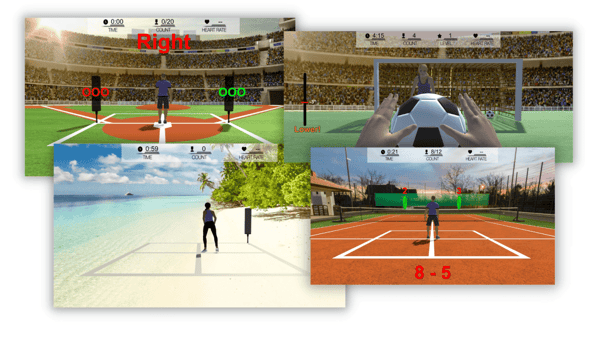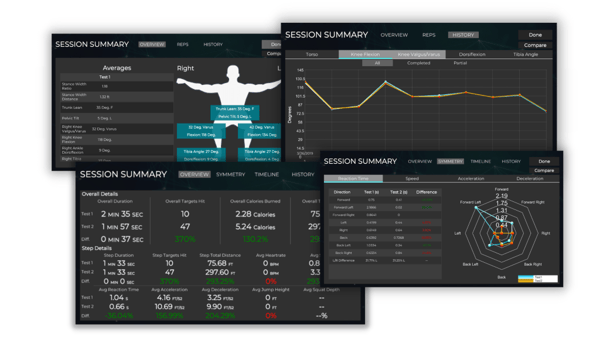ON-DEMAND TRAINING
Leverage TRAZER to achieve Better Outcomes.
WELCOME TO TRAZER XP 101
We know you're not new here - but want to ensure we provide a full training resource on all things TRAZER XP. Keep an eye out for the 🚨 icon - signaling a new function or feature!
We're so glad to see you here! Let's get started.
TRAZER XP 101 Learning Objectives:
- Gain a comprehensive understanding of what TRAZER is and how it works
- Master using the equipment and navigating the software
- Learn to speak about TRAZER with your Users
- Learn to create Users and select and start Activities
- Understand the reporting structure
Let's start with the basics
What is TRAZER?
TRAZER technology combines immersive simulation, motion capture analytics, and reaction-based challenges to help every body move better.
Designed for physical rehabilitation, strengthening, and enhancing performance, TRAZER aligns perfectly at the point where biology, technology, and data intersect to engage the brain + body and provide insights that are prescriptive, predictive, and preventative.
Watch a brief video to see TRAZER XP in action:
How does it work?
Simply put, TRAZER is Hardware + Software + Data Analytics.
TRAZER XP hardware (unit) consists of a depth-sensing camera and a specialized hard drive that runs TRAZER HIPAA-compliant cloud-based application. TRAZER uses the camera to track 🚨 32 points on the body and proprietary algorithms to process millions of data points in real-time. The unit connects to a TV for display and can be installed on a wall or on a wheeled stand to be moved within your facility.
.png?width=600&height=338&name=Layered%20Graphics%20for%20Website%20(2).png)
The TRAZER software includes more than 150 interactive Activities built to assess different types of movement: Dynamic Movement, Kinematics, Neuromechanics, and Balance.

Once an activity is selected, a 3-second calibration will begin. During calibration, the camera is searching for 25 points on the User's body to lock onto in order to track their movement. Once calibrated, the User will appear on-screen as an avatar, reflecting their movements in the real-world. As the User moves and reacts to the cues on-screen, the software is recording and analyzing millions of data points.
Upon completion of the Activity, TRAZER generates a robust report of the User’s movement data.

Using the Equipment
🚨 The TRAZER XP Unit
- Requires connection to a power source and a TV (via HDMI) for display.
- Requires internet connection.
- Push the black button right-hand side on the far back to turn it on. It will take a moment for the system and application to load.
- When the application is ready, the Sleep Screen will show your Site Name. Click anywhere on the screen - using your TRAZER remote - to enter.
.png?width=600&height=600&name=equipment%20mockups%20(13).png)
The Remote
This remote will allow you to navigate your TV screen like a computer mouse. Your TV remote is separate, and cannot control the TRAZER application.
PRO TIP: Aim the remote at the TRAZER unit - not the TV.
.png?width=600&height=600&name=equipment%20mockups%20(15).png)
- Click Ok to select/confirm
- The Cursor function is activated and deactivated by pressing the mouse arrow button located the the top left of the OK button.
- The scrolling function is activated if the Cursor function is turned off. Scroll by clicking the up, down, right, and left arrows around the OK button.
- You can scroll with the Cursor function activated by clicking and holding OK and dragging up or down.
- The keyboard on the back of the air mouse can be used while creating Users, in the search tab, or in the Admin Settings section.
Make sure to plug the charging cord into one of the USB slots on the side of the TRAZER XP unit to charge the remote.
🚨 The KEYBOARD
The keyboard connects to your TRAZER XP unit via bluetooth. They keyboard allows easy entry of User Profile information, Activity searches, and Admin Settings.
.png?width=600&height=600&name=equipment%20mockups%20(14).png)
Make sure to plug the charging cord into one of the USB slots on the side of the TRAZER XP unit to charge the keyboard.
Navigate the System
Getting started with a new User
Prior to the Session
TRAZER XP utilizes an extremely powerful camera - and as with many medical devices - there are factors to consider to create an optimal environment for the best User experience and most accurate results.
Tips to create an optimal experience:
Suggest your Users come to their appointment/session in
- Fitted clothing
- Solid colors - or free of significant patterns
Introducing TRAZER
A critical aspect of your users' experience is understanding the value of their TRAZER sessions.
Throughout this section, we're going to use examples of a client/patient named Ray who has never used the system. Let's introduce him to TRAZER:
Welcome back, Ray. Today, we're going to work on your mobility with the TRAZER system. TRAZER has a camera that sees a lot more than I can, 32 points on your body to be exact... and will report back to us how well you move in this space. Now the fun part is, you get to play an interactive game - and I get insight into your movement to identify what areas we should focus on. The first thing we're going to do is create your profile so we can track, and actually visualize, your progress over time.
Creating a User
All of your Users need their own unique TRAZER profile to record all of their reports and compare their data over time. Before beginning a session with a User, click Login on the top-right of the screen, and use the search bar to find and select the User.
When creating a User, you will need to fill out the required information on the User Profile. From there, you can use the arrows to enter Sport and Injury information, if applicable, or click Create User to skip those sections. You can always update this information later from the Unit or from your Portal.
Here's a brief video demonstrating creating a User Profile on TRAZER XP.
🚨 The User creation process has been simplified to increase efficiency by removing the email address requirement and allowing the Profile to be created as soon as all required fields are met.
User Profile information is factored in to some reporting metrics and also changes the appearance of the User's avatar.
A Profile Access PIN is an (optional) additional level of security for a User. If a 4-digit PIN is entered during creation, the PIN will be required to access the Profile.
🚨 A Medical Record Number can be logged optionally on the Profile to enable searching by this number in the Portal and to display the number on Reports.
Sport and Injury information are optional. This data can be used while running analytics in the Portal.
Users can also be created via a QR code. You - or your User - can scan this code from the camera of a mobile device. You will be taken to a web page where you enter a unique code (shown on-screen) and enter User Profile information. Upon completion, the User record will exist in the system and be immediately available to select from the Select User menu on the Unit.
You can also import Users in bulk to your TRAZER Portal.
Once your User is created, you can search for their profile and select them from the list to log them in.
🚨 The User selection menu utilizes a search feature (instead of displaying all available Users) for added privacy and data security.
It's important to remember to log Users out when they are done using TRAZER to prevent accidental use of an incorrect User Profile. Click the username in the top-right corner, and click Logout.
New User Orientation
.png?width=3840&height=2160&name=Screenshot%20(45).png)
Back to our Ray example...
Let's get started:
Ray, we're going to start with a quick practice session so you can learn how TRAZER works. Once you're in the Activity, you'll see yourself on screen, in the simulation, as an avatar.
As soon as you see a target pop up to the left or right of your avatar, I want you to move your body in that direction to guide your avatar to it on the screen.
Before I click Start, stand here right in the middle of our TRAZER area and face the TV. I'm going to step aside while the camera focuses on you.
You do not need to complete this Activity, the purpose is to ensure your User understands how to move themselves following on-screen cues. Once they are comfortable with the simulation experience, you can move on to an Activity of your choice.
Starting an Activity
We recommend the first Activity you do with every new User is an Assessment. The Assessments category of Activities are standardized and best for establishing the initial baseline of a User's performance. As the User performs this activity over time, you can benchmark their progress and compare sessions to monitor progression/degradation over time and chart changes.
The following video demonstrates how to navigate the system to select and start an Activity:
🚨 The Filter function now filters the entire Activity Library and filters by various Activity Types.
We're going to establish a baseline for Ray with one of our most popular Assessments: the Lateral Agility Screen-90. The LAS-90 is a 90-second test of a User's ability to see random stimuli and react by moving to the left or right. This test is a great starter Activity for a new User to build the User's confidence in using TRAZER. It will give us insight into both Ray's reaction time - how long it takes him to process information and move as directed - as well as to any movement asymmetries - or difference between movement to the left and movement to the right.
Ray, now that you have been oriented to TRAZER, I want to establish a baseline of your movement. We're going to look at how you move left and right, from side to side.
Move as effectively as possible, and to the best of your ability.
🚨 When a User moves too far out of the perimeter of the field-of-play, the avatar will disappear, instead of pausing in a pose.
Reviewing the Report
Once an Activity is complete, a report will load on-screen. You will notice a difference between reports from Activity to Activity as the system will show a report relevant to the Activity and metrics.
The following video explores the structure of reports:
🚨 New functions are available such as Test Notes, Printing, and comparing up to 6 Tests.
You will always be taken to an overview report, showing summarized information from the Activity.
Back to our Ray example...
Let's look at Ray's Report:
%202.png?width=800&height=450&name=Screenshot%20(52)%202.png)
The overview report shows both Overall details and Step details as a high-level overview for the test and the step selected.
The Overall metrics include data from the start of the activity - including calibration - to the end of all of the steps in the activity. This specific activity is only 1 step. For multi-step activities, you can click the Choose Step drop-down to view metrics for each step.
Different types of activities will show different report sections. This activity is a Dynamic Movement activity so you will see a Symmetry Report. (We will learn about the different types of reports and dive in to metrics in TRAZER XP 201.)
.png?width=800&height=450&name=Screenshot%20(53).png)
The Symmetry report has a secondary menu to segment each metric: Reaction Time, Speed, Acceleration, and Deceleration.
On each tab, you will see an average of the reported metric listed by direction of movement. These metrics are also shown to the right plotted on a spider graph.
We can see Ray's reaction times for targets to the left and right. The average time from the moment the target appeared until he initiated movement in that direction, was .26 seconds for targets to the left and .34 for targets to the right.
TRAZER identifies asymmetry between directions in a color code. The difference is displayed as a percentage and to which side.
- Under 10% = green, symmetrical
- Between 10-20% = yellow, asymmetry detected
- Above 20% = red, significant asymmetry detected
So the difference in Ray's reaction times to the left and right was in the red zone. He reacted 22.59% faster to the left.
You will want to check for asymmetry in all 4 tabs.
In the Timeline Report, we can see these metrics - as well as heart rate - charted at 10-second intervals through the course of the activity.
.png?width=800&height=450&name=Screenshot%20(58).png)
The History report shows these metrics charted over time so we can visualize progression every time Ray does this activity.
What next?
Now that we've established Ray's baseline and identified asymmetries, we can create goals for him and come back to this activity to benchmark his progress. Keep in mind - in this example we used a LAS-90 Assessment - you can utilize any TRAZER Activity, or multiple Activities, to establish a Baseline.
The best way to utilize the system is to establish a baseline of your User's performance and then repeat this Assessment to benchmark progress.
Whether healthy or injured, a Baseline provides highly valuable information for both you (the Provider) and your Users. Once a Baseline is established, you can create customized goals with comprehensive data that allows you to track progress, and most importantly, gives you definitive charting in case of injury or post injury - making the intangible, tangible through data.
To easily remember which Activity you used as a Baseline, you can use the Favorites function to save Activities specifically for the logged in User.
.png?width=600&height=338&name=favorite%20button%20(1).png)
🚨 Click the heart icon to save an Activity as a Favorite.

When the User is logged in, favorited Activities will be pinned to the top of the Activity Library so you can easily find your User's baseline Activity or other favorite Activities.
Every repetition of an Activity serves as a Benchmark, tracking progression or degradation over time. These benchmarks give you the unique ability to see the unseen, measure progress, and adjust your care plan or training regimen accordingly.
Our co-founder, Barry French, discusses Baselines + Benchmarks:
TRAZER Workouts, Rehabilitation Protocols, Assessments, and Drills all can be used for rehab and/or training.
We will deep-dive into the different types of Activities in TRAZER XP 201.

Knowledge Check
Login to the system with your Admin credentials. (If you do not yet have Admin credentials, contact your Super Admin.)
Now log yourself in as a User. Search by your first name, last name, or username in the Select User menu and select your Profile.

Knowledge Check
Complete the User Orientation Activity.

Knowledge Check
Establish a baseline for yourself with the LAS-90 Assessment. Do you have any asymmetries?

.png?width=500&height=268&name=TRAZER%20Teachable%20Course%20Cover%20(1).png)